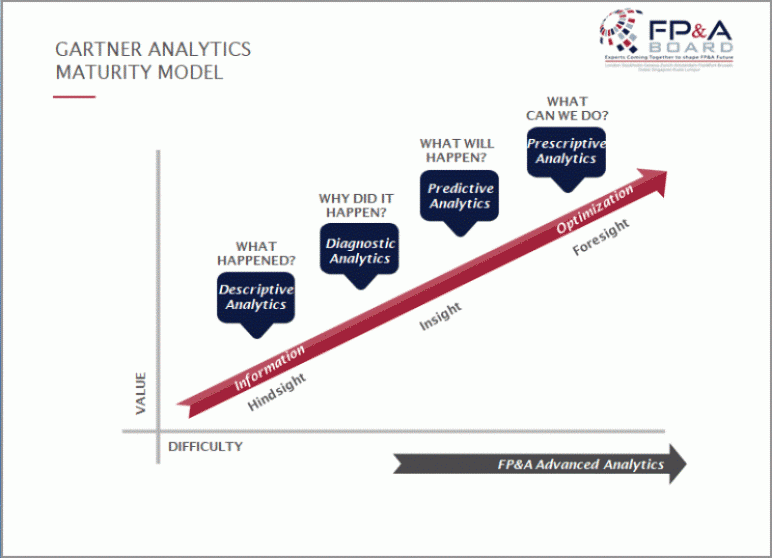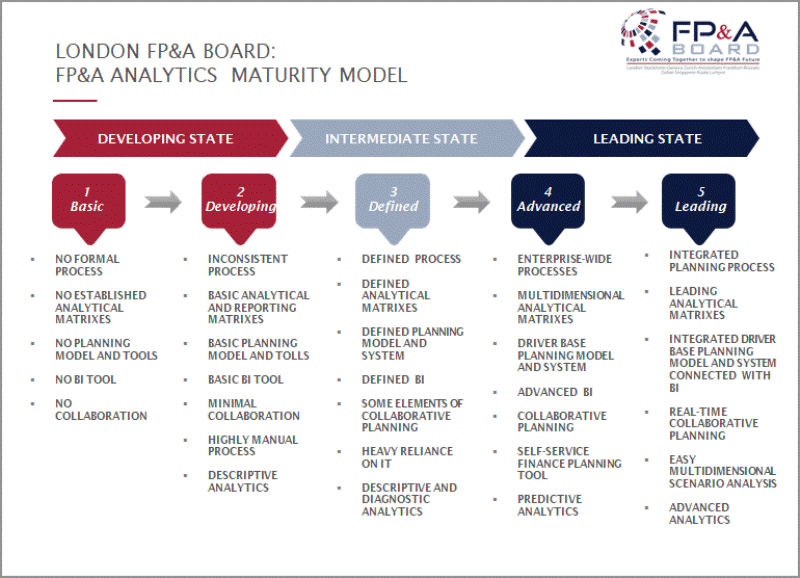 Introduction
Introduction
The future is unpredictable, the current business environment is harsh, competition is fierce. In these times of change, modern FP&A is both exciting and challenging. It is exciting because it utilises better and more sophisticated tools than previously, can embrace automation and the incredible power of online collaboration. However it is difficult because old finance management practices are still alive: they are inadequate for the modern world, but FP&A professionals continue to live from a deadline to a deadline and have no time to stop, change, re-write, and reconsider.
Analytical transformation reduces finance departments’ costs. e.g. robotics and automation, shared services, centers of excellence have already processes of many finance departments. But what about FP&A? In many cases, it still lives in the 20th century. It is a well-known fact that Excel continues to be the prevalent analytical tool used by finance professionals. The quality of data for FP&A analytics remains poor and the FP&A time wasted on the data reconciliations and cleansing. The financial analysis task thus takes on the form of “firefighting”, leaving no time to re-think and re-design the existing non-value adding processes.
Obviously, changes in the FP&A framework are driven by transformations of analytical procedures in general. For its 10th meeting, held in mid-March 2016, the London FP&A Board embarked on developing the FP&A Analytics Transformation Model.
The meeting was sponsored by Metapraxis, the consultancy, analytics for financial professionals and software provider and, by Michael Page, the specialist recruitment firm, which now provides its offices as the venue for Board meetings in central London and abroad.
20 senior finance practitioners from the UK, USA, Denmark, Switzerland, Ukraine, Germany, and Netherlands came together to brainstorm on the following questions:
- What is advanced analytics for FP&A?
- What are the stages of FP&A analytical transformation?
- How should the FP&A Analytics Maturity Model look?
What is advanced analytics for FP&A?
There are a lot of professional debates about the role and purpose of finance analytics; the marketplace is flooded with alternative definitions of different analytics types. Many advanced analytics definitions come from the IT profession, however these need to be adjusted in order to better address the finance world.
The Gartner model, shown below, presents an overview of different kinds of analytics.

It was agreed at the London FP&A Board meeting that FP&A advanced analytics start from the Insight stage and utilise predictive and prescriptive types of analytics. In other words, FP&A advanced analytics is Proactive and Forward-looking Analytics.
Traditional budgeting and planning analytical processes are still centered around Descriptive and Diagnostic Analytics: the most backward-looking and reactive processes. A good example is the traditional Variance Analysis.
FP&A advanced analytics is based on a driver-based planning and forecasting process. It is important to identify a number of key business drivers: not more than 10 or 20. If effective, the process can describe 80% of the outcomes by only focusing on 20% of the total drivers. The simplification helps to speed up the analytics based decision-making process and to increases its flexibility and agility.
How about the optimization stage of the analytics? Are FP&A departments ready for prescriptive analytics? The London FP&A Board agreed that the foresight stage of FP&A analytics is not generally present in the FP&A departments yet. Some of the board members think that it is not possible to automate complex and strategic analytical FP&A decisions: these complex analytical scenarios should be run by human beings, not machines.
However, there are some routine and repetitive tasks that could be automated in order to release valuable time for the advanced analytics.
FP&A Analytics Maturity Model
The FP&A Analytics Maturity Model, shown below, presents an overview of the three states and 5 stages of the organisational analytical transformation.

There are 3 states of FP&A Analytics Maturity: Basic, Intermediate and Leading. The stages of the maturity could be described as following:
- Basic
- Developing
- Defined
- Advanced
- Leading
Let us look at each stage in more details.
1. Basic Stage of Maturity
It is described by the following characteristics:
- No formal analytical processes
- No established analytical matrixes and business drivers. The financial model is in the basic or non-existent state
- No BI tool and dedicated planning system
- No business collaboration
An example of organization at this stage would be a business startup, where the processes, models, systems and measures are not yet defined.
It can also happen within a mature organization, when it decides to spin off one of its operations.
2. Developing Stage of Maturity
Characterized by the following
- Inconsistent planning and forecasting processes
- Basic analytical matrixes and drivers.
- Basic planning model and tools (most likely excel-based)
- Basic BI tool
- Minimal and inadequate planning collaboration
- Analytics is mostly descriptive and backward-looking
All organizations will pass this stage in the process of developing their FP&A framework. This is necessary step of development. The desired outcome is for an organisation to progress into the defined and advanced stages of the development process.
Sometimes, an organization can stack at this “developing” state. It happens for reasons of poor management, dysfunctional business culture and inadequate investment in analytics. Such a stall can prevent an organization from unlocking its full potential and competing in the modern world.
3. Defined Stage of Maturity
Currently, many global organisations reside at the beginning of this stage. It is characterized by the following :
- Defined Planning processes
- Defined analytical matrixes and drivers
- Defined planning model and system
- Defined, but disconnected from planning BI-type solution
- Some elements of collaborative planning is present
- There is heavy reliance on IT support
- The analytics types are descriptive (What?) and Diagnostic (Why?)
This Intermediate state of analytical transformation is characterized by relative stability: companies are able to stay in this stage for many years. The processes are stable, but not “best in class”, they are adequate for the traditional budgeting, planning and forecasting process. However, they are arguably highly inadequate for “new world” planning.
4. Advanced Stage of Maturity
Best in class modern planning processes reside at this space:
- Enterprise-Wide planning processes
- Multidimensional analytical matrixes, leading KPI’s and business drivers
- Driver based planning process and flexible planning system
- Advanced BI solution: it is partly connected with the planning process
- Collaborative planning process
- Self-service planning system and process, low reliance on IT
- Predictive analytics (What will happen?)
5. Leading Stage of Maturity
This is the ultimate goal for which organisations should aim.
- Integrated Planning Process (IPP)
- Leading Analytical matrixes and drivers.
- Integrated driver based planning process (both horizontal and vertical)
- Planning system is fully integrated with BI
- Real-time collaborative planning process
- Advanced (Proactive) analytics
Conclusions
Analytical transformation is an ongoing process. We will see more transformation in the future: system implementations, restructuring of processes, re-defining and simplifications of the models, automation of the routine tasks and applying proactive advanced analytics.
Currently, the majority of organizations are stuck at the defined stage with some turning to the advanced for the best in class companies. At the leading stage, all planning processes will be fully integrated, allowing for multidimensional advanced analytical process. This is where FP&A will be able to use big data analytics and fully transform organizational corporate performance management and decision making process.
Subscribe to
FP&A Trends Digest

We will regularly update you on the latest trends and developments in FP&A. Take the opportunity to have articles written by finance thought leaders delivered directly to your inbox; watch compelling webinars; connect with like-minded professionals; and become a part of our global community.
